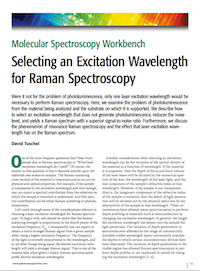|Articles|December 1, 2016
- Spectroscopy E-Books-12-01-2016
- Volume e4
- Issue 2
Selecting an Excitation Wavelength for Raman Spectroscopy
Author(s)David Tuschel
Advertisement
Here, we examine the problem of photoluminescence from the material being analyzed and the substrate on which it is supported. We describe how to select an excitation wavelength that does not generate photoluminescence, reduces the noise level, and yields a Raman spectrum with a superior signal-to-noise ratio. Furthermore, we discuss the phenomenon of resonance Raman spectroscopy and the effect that laser excitation wavelength has on the Raman spectrum.
Read more
.
Read
.
Articles in this issue
about 9 years ago
Raman Mapping of Spectrally Non-Well-Behaved Speciesabout 9 years ago
Photoluminescence Spectroscopy Using a Raman Spectrometerabout 9 years ago
Raman Thermometryabout 9 years ago
Characterizing Modified Celluloses Using Raman SpectroscopyNewsletter
Get essential updates on the latest spectroscopy technologies, regulatory standards, and best practices—subscribe today to Spectroscopy.
Advertisement
Advertisement
Advertisement

